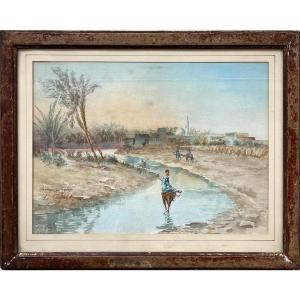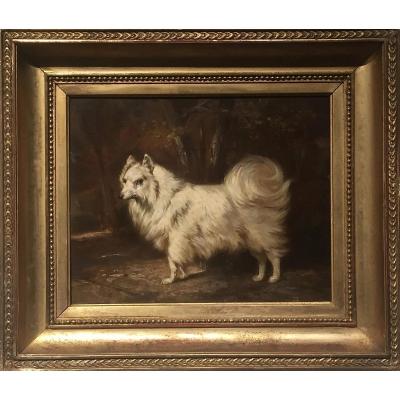(Bayeux 1861- 1943 Boulogne sur Mer)
Set of 6 paintings in the troubadour style around the history of the château de Beaudiment (or Baudiment)
tempera on canvas
311 x 180 cm (each canvas)
sold as is, without stretcher
For further information :
Ferdinand Louis Marks (1861-1943) was born in Bayeux. He was the brother of Albert (1871-1941), who also intended to become a painter. Originally Prussian, their family settled in Metz after the annexation of 1871.
Ferdinand Louis is best known for his genre paintings and landscapes, in oil or gouache, from Normandy to Lorraine, via the banks of the Seine in the Paris region. Anchored in his time, realistic in his depiction of barges on the Seine or Norman ports, he nevertheless had a period of eighteenth-century inspiration, offering very pastoral scenes and experimenting with caprice. He exhibited at the Paris Salon from 1884 to 1891, the same period as our paintings, which were probably commissioned by the then owners of the Baudiment estate. He had a son, Ferdinand (1891-1932), also a painter and his pupil, who exhibited with him at the Salon de Metz from 1930 to 1932. Ferdinand Louis died in Boulogne-sur-Mer in 1943.
Our paintings were probably commissioned when I was young. Their subjects refer to the history of Château de Baudiment, located in the hamlet of the same name in the commune of Beaumont-Saint-Cyr (Vienne). The names and dates associated with the Baudiment family, founders of the estate, are recorded as early as 1060 in the cartulary of the Abbey of Saint-Cyprien in Poitiers. Lansberge de Baudiment, benefactress of Saint Cyprien (himself featured in one of the paintings), her sons Richard and Aléard, and her descendant Isabeau at her betrothal in 1362 are all mentioned and depicted. Our six scenes retrace key events in the early centuries of the château and the dynasty, right up to its acquisition and radical transformation by the Neufchèze family in the 15th and 16th centuries.
It is likely that these paintings, in the form of ogives, were commissioned by the owners of the estate in the 1880s to decorate the interior.
Notable museum :
Musée Carnavelet, Paris

















































 Le Magazine de PROANTIC
Le Magazine de PROANTIC TRÉSORS Magazine
TRÉSORS Magazine Rivista Artiquariato
Rivista Artiquariato